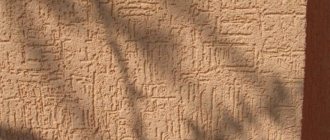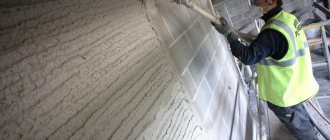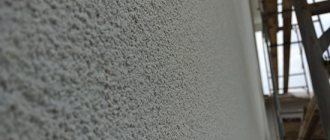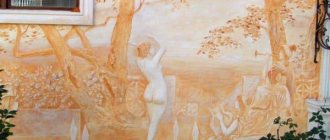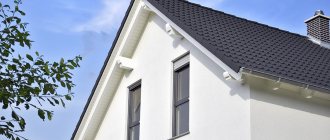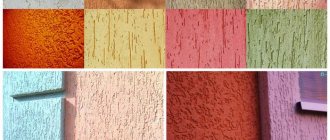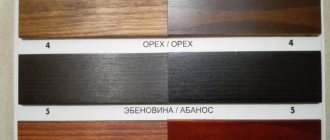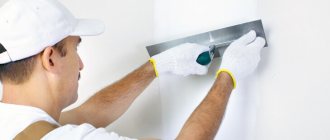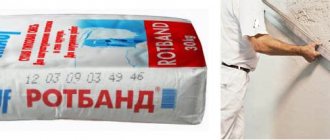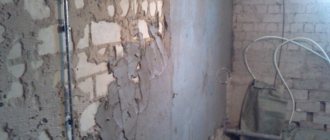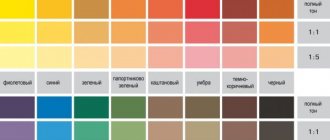Updated: 04/22/2021 16:53:17
Expert: Andrey Nikolaevich Kuznetsov
*Review of the best according to the editors of expertology.ru. About the selection criteria. This material is subjective in nature, does not constitute advertising and does not serve as a purchase guide. Before purchasing, consultation with a specialist is required.
The facade of the building is regularly exposed to negative factors. Among them: moisture, wind, temperature changes, dust settling, ultraviolet rays, mechanical shocks from falling branches or stones. In view of this, it is necessary to plaster the outside of the walls of the house with especially strong compounds designed to withstand such loads. It is also important that the mixture allows you to create a beautiful surface. Here are the best plasters that have already stood the test of time and serve well on thousands of facades in Russia.
Various types of facade plaster
Facade plaster comes in the following varieties:
- "Bark beetle";
- With pebbles;
- In the form of a mosaic.
Bark beetle facade plaster is justifiably considered the most popular, which has a strong effect on many, and besides this:
- It is light in weight and does not put much strain on the walls;
- Safe from an environmental point of view, that is, without the presence of components harmful to health;
- Holds well at large temperature differences in the range from minus fifty-five to plus sixty;
- Does not lose its appearance in direct sunlight;
- Cleans well with a sponge and vacuum cleaner;
- Looks great with a variety of dyes;
- Affordable.
Application of this type of facade plaster for external walls is carried out using a grating method using the grains contained in the composition. They are what make an attractive drawing.
Types of plaster for facades
Depending on the components, there are four types of compositions:
- mineral;
- acrylic;
- silicone;
- silicate.
Different types of plasters have different ductility, strength, vapor permeability, service life and other parameters.
Unterputz
Before carrying out decorative finishing, you should first prepare the wall. In this case, Unterputz façade plaster is an excellent option for any mineral base (gas blocks, brick, concrete).
This mixture is made up of various cement additives and sand. Its universal qualities are well used in places where there is high humidity and heavy load, both for exterior and interior finishing.
Its obvious advantages are:
- The presence of good plasticity, when the mortar mass can be applied in a layer of ten to thirty-five millimeters;
- Increased moisture resistance;
- Possibility of application, both machine and manual;
- Neutrality and efficiency.
Do-it-yourself technology for plastering external walls
First, let's look at how to level and prepare external walls for applying decorative finishes.
Preparing the surface of the building facade
- Remove old finish.
- Clean the walls with a stiff steel brush.
- Inspect the surface to identify cracks and dents (roughness on the wood, burrs), etc. If there are any, clean them with sandpaper.
- Wash the wall with a damp sponge (with soap if necessary) and dry.
- Use a plumb line or level to check the verticality of the walls.
It is recommended to impregnate wooden facades with an antiseptic solution. If the walls are made of brick, stone, or aerated concrete blocks, then use empty masonry (with incomplete filling of the seams on the front side). This will ensure better adhesion of the wall surface to the plaster. If this has not been done, then before plastering, jointing is carried out (the seams are deepened with a chisel and hammer by 1 cm and cleaned with a brush). On concrete walls, with an ax or perforator, notches are made with a depth of 5 mm and a length of 5 to 10 cm in increments of no more than 4 cm.
jointing and notches for plaster
To improve the adhesion of the plaster to the surface of the facades, a primer is first applied. Its composition is selected taking into account the nature of the wall surface (concrete, wood, brick, etc.). The primed walls are left to dry for a day.
How to plaster: stages of applying a leveling layer
To obtain a good result, the plaster mixture is applied in three layers:
- Spray (starting) - from 3 to 9 mm (depending on the nature of the surface, a thicker layer is needed on wood).
- Ground - from 7 to 8 mm, if the plaster contains gypsum, then 9 - 12 mm.
- Covering (finishing) - from 2 to 4 mm.
To strengthen the facades and ensure rigid adhesion of the leveling layer, the plaster mixture is applied to the reinforcing mesh. To do this, after the primer has dried, apply the first layer of plaster and embed the mesh in it. Wooden facades can be reinforced with the same mesh or shingles - narrow wooden slats nailed diagonally crosswise. If the walls are insulated with mineral wool or similar insulation, then an adhesive solution is applied to it to fix the mesh. For example, ARMIERUNGS-GEWEBEKLEBER 215, PALADIUM PalafiX 402, Glims KF and others.
The procedure for plastering facade technology:
- The reinforcing mesh is installed on the street wall or on the insulation.
- If necessary, guide beacons made of metal profiles are attached. They are fixed to the wall with plaster mortar, and verticality is checked with a level.
- Apply the plaster mixture with a spatula or paint bucket, starting from the bottom and gradually moving upward. With the machine plastering method, a compressor and a pneumatic bucket are used for this.
- The applied layer is leveled using the rule. When using beacons, the rule rests on two guides and rises up, leveling the plaster layer.
- The second layer begins to be applied after a day. On the fresh layer you need to make notches or grooves to ensure better adhesion to the finish. You can use a notched trowel for this.
- After another day, apply the last layer - the covering. Dilute the plaster for it to a creamy consistency.
- After the finishing layer has dried, use a special trowel to grout. Press the device tightly against the surface, making circular movements clockwise. After processing the entire facade, rub it again in a straight line. If you need to achieve a perfectly flat surface, then wrap the grater in felt or felt.
Grout
If the decoration of the facade is carried out on the basis of leveling plaster, then immediately after applying the last layer, without waiting for it to dry, they begin to create a pattern or relief.
To do this, use special rollers with patterns, stencil stamps or a trowel. Options for drawings can be very diverse. Stamps are not very convenient, since they have to be washed frequently, and the expression of the design in different places is not the same due to different pressure forces. With a trowel, you can create a stone texture on the wall by simply making chaotic movements with it. If the plaster is planned to be painted, then after creating the texture and drying it is primed again and after that the paint is applied.
Pebble and mosaic
A variety of patterns helps to achieve finishing using stones in the composition. The most famous are “polka dots” or “fur coat”. Thick crumbs of natural origin densely cover the entire surface, so the facade has a special appearance.
In addition, it does not require additional painting at all, and such plaster lasts quite a long time without changing its qualities.
Characterized by:
- Low cost;
- Protection from external factors;
- Easy to apply.
Marble chips for the facade are classified as a mosaic type of plaster frame. Made from various types of granules, it is more durable and looks very beautiful on the walls.
If you follow the rules when applying plaster, the surface will look just perfect - dense and solid. Uniqueness is created due to the presence of grains of different sizes in the mixture, which form the necessary mosaic pattern on the walls.
If the obvious advantages are resistance to the sun and vapor permeability, then there is one disadvantage, but it is extremely significant. It is very difficult to restore the damaged part.
Installation and finishing work
Each type of exterior plaster requires different application methods. However, the process sequence is basically the same:
- Before applying plaster, the surface requires preparation. Sometimes special beacons are used so that the building acquires the necessary harmony.
- If bark beetle is used, then the wall is pre-insulated with foam plastic or other heat-insulating material.
- The solution is applied from top to bottom, as it tends to float under its own weight. As it floats, the solution must be pulled up.
Applying facade plaster
At the final stage, the façade is given texture, shaped protrusions are made, a “fur coat” is applied, etc.
It is worth noting that during the application of any solution and the period of its hardening on the facade, it must be protected from external influences. There should not be a break between applying the solution, so all work should be clearly planned.
Travertine
A fairly popular variety is travertine facade plaster, which imitates the natural nature of stone. Thanks to it, facade walls are highly practical, along with a spectacular appearance.
When applying such a coating, it is necessary to have both experience in such work and the appropriate skills. That is why it is most often performed by qualified specialists who have a certain specialization in the field of finishing.
The composition is based on natural stone. Italian and Russian manufacturers have achieved amazing similarity of the coating with the texture of natural material.
If we talk about the fundamental features, they include:
- The ability to create facades that are unique in appearance and have a high level of aesthetics;
- Complete safety from an environmental point of view;
- Easy application and low maintenance;
- Resistance to harmful microorganisms and the ability to “breathe”.
Thanks to this type, buildings look very impressive and can be easily tinted. If desired, it can be made both in pastel tones and in more saturated shades, which allows it to determine its special place in the interior style.
The binders in the composition allow classification into:
- Silicate with liquid glass, which does not have high strength characteristics, but has excellent vapor permeability characteristics and adaptation to atmospheric manifestations;
- Mineral based on cement or limestone. It has excellent strength and resistance to external influences. Universal. Can be used for finishing, both from the inside and from the outside.
Mineral
This type of plaster is characterized by the fact that the basis for it is cement. The mixture usually consists of cement, river or sea sand, and lime.
Manufacturers add plasticizers and modifying additives to the mixtures, accelerating setting, imparting frost resistance or corrosion resistance.
The positive qualities of mineral facade plasters are:
- mechanical strength and good adhesion to the building facade:
- combination of water-repellent properties with vapor permeability;
- resistance to temperature changes;
- relative cheapness.
Negative sides:
- is not subject to tinting, so to change the color you have to use facade paint after finishing the plastering work, the choice of colors is poor;
- without the addition of plasticizers, very low elasticity and tendency to cracking.
Gypsum plasters that have recently appeared on the market are afraid of prolonged direct contact with water, and due to the abundance of polymers in their composition, they do not allow steam to pass through and are not environmentally friendly.
Options for applying facade plaster
Three main types of application technology:
- In one tone with the formation of a beautiful surface, very similar to the texture of natural stone;
- With a combination of one or more shades, formed by alternating light areas with dark ones. The surface can be “aged” if a silvered substance is used for this purpose;
- A special torn technique, when the formation of a patterned part is achieved by applying layers with different colors in a chaotic order. This way you can get a unique pattern.
If we talk about technical design, it can be textured, monolithic, or clearly imitating natural stone.
Silicate
Silicate-based plaster is a decorative textured material intended for application in a thin layer.
It has good vapor permeability and is used with insulation materials like mineral wool, which also allow air to pass through. It has the ability to repel moisture and dust and retains its decorative properties for a long time. Does not lose its properties when washed.
Photo of facade plaster for exterior work
Bark beetle
Many residents of Moscow and the Moscow region are confident that the bark beetle has “lost” its position and is no longer in trend. In our region, perhaps, this is the case. Owners of private houses prefer pebble texture rather than bark beetle. However, traveling around the Volga region and the North Caucasus, we noticed that most houses are decorated using the “bark beetle” texture.
It is difficult to say why regional trends are so clearly visible, but one thing is clear - the bark beetle is loved by the people and will enjoy deserved popularity for a long time.
Bark beetle is a facade decorative plaster that imitates the surface of a tree affected by the bark beetle. The texture is made in the form of vertical, horizontal or wave-like patterns.
WHITE – WHITE DECORATIVE PLASTER
White façade decor is a choice towards laconicism, minimalism, light and openness. This is rightfully the most universal color that can be used in exterior styling.
The white color palette is not as neutral as it seems at first glance. Snow-white gradually turns into white-lilac, cloudy, white-blue, marshmallow, vanilla, as well as ice color and other rare shades.
The white facade looks harmonious with all dark and bright shades, making them more neutral and balanced. From the point of view of the combination of the facade and the roof on the roof, white will visually create freedom and a sense of space.
In almost all stylistic directions you can find white plaster. This image will add brightness and attractiveness in combination with the environment.
PASTEL COLORS FOR PAINTING DECORATIVE PLASTER
The pastel colors of the facades are distinguished by a variety of calm shades. Each individual color is present in the pastel group, but in a more faded form. This category is divided into cold and warm tones, so the user can choose the direction of the future design.
Pastel colors should be chosen as a compromise between bright and calm. Green will emphasize the naturalness of the surrounding landscape, yellow and orange will fill the building with light and warmth, pink will give contrast and romanticism. As for blue and blue shades, they look fresh in all the proposed positions.
Purple color textured plaster
The purple color of the plaster is a contrast to the yellow shade. This choice emphasizes the artistry, calmness, and sensuality of its owner. A rich tone will balance the entire architecture of the building, due to the combination of warm, dark and bright shades in one.
The classic “representative” of purple is plum, which stands next to the blue palette. The lightest shade is considered to be heliotrope, associated with a natural floral theme. Often, purple color is used to highlight some part of the wall in combination with gray, white, and pastel.
Pink color decorative plaster walls
Despite its romanticism and sensuality, pink is rightfully considered a neutral shade in facade design. Painting the plaster pink will allow you to achieve a balanced saturation if the owner does not dare to use brighter colors. Choosing pink does not mean that the object will look like “Barbie’s house.”
This color scheme is skillfully combined with gray, white, black, pastel, which makes it universal in the arsenal of any colorist. The main thing is not to combine pink with reddish, lilac tones, otherwise the walls will lose their intended luster.
Green colors of houses - plaster
It is not for nothing that green is considered the color of nature, which has a beneficial effect on moral and psychological well-being. Greenery is visually perceived as calm and solitude with nature, so many designers recommend adding at least a green accent to the design of the facade.
The facade of the house in green is divided into positions:
- Malachite is a rich herbal.
- Green meadow - classic warm.
- Spring - a combination of mint and blue.
- Green and forest green are almost identical and the difference is one tone.
- You should also not confuse sea green and jade, as we can see in the photo - each of them is individual.
- The calm subsection of greens opens with apple and mint.
- As for olive, camouflage, khaki, asparagus, these colors are the result of the addition of gray and brown.
Gray color – gray decorative plaster
Painting plaster gray is a universal format if you are planning to decorate your home in a modern style. A color of this class combines calm, severity, brevity, and richness. The composition of gray may include blue, green, cyan, black, which to a certain extent change the saturation.
Gray is the anchor for any color, so you can't go wrong with it.
Blue color facade plaster
The blue color of the plaster symbolizes lightness and peace. In many cultures, the color of heaven is considered sacred and divine, which is why it can be found in church architecture.
To make the facade of the house look balanced, you can completely limit yourself to just one blue color. It looks complete on its own and does not require the addition of brighter colors. The exception is white and all its shades, since these two directions complement each other.
Pale cornflower blue, as well as “Niagara” and gray are very popular in coloring decorative plaster. These tones look calm, rich, and at the same time do not require lightening with secondary colors.
Blue color - cool colors for painting decorative plaster
Cladding the facade of a house with blue color is popular due to its conservatism, nobility, and fullness. This color emanates prudence and sincerity, therefore, in the exterior, such a palette acquires an aesthetically attractive meaning. Blue goes best with white, gray, and red, so the façade can be painted in several palettes.
This color category is distinguished by its rich variety. The most prominent “representatives” are:
- Sea wave and azure - the water theme is actively used in the style of facades.
- Sapphire and ultramarine are a combination of blue and violet.
- Denim - balanced blue and light blue.
It should be noted that the category of blue shades also includes all the main shades of blue. Therefore, for a broader vision, you should rely on this color map, which gives more freedom of choice.
What color can the decorative plaster on the facade of your house be? Selection by style
You might think that painting plaster is a simple choice that does not require a special approach, because “pick the color you like and be happy with the result.” But it is not so! The palette directly depends on the chosen style in which a residential building or other institution is built. According to experts, the cladding of the facade of a house is divided into the following categories:
- Provence . The predominance of light pink, blue, milky, as well as lavender and mint. The main emphasis is on tenderness and freshness, which is inherent in the French style in home decoration.
- High-tech - the use of black, white, metallic, and gray. The ultra-modern style features a discreet and laconic design. It is recommended to select even and smooth plaster.
- Baroque - absolutely all pastel and warm colors, especially gold. The main task is to emphasize the luxury that the Baroque style is filled with.
- Eco is the color of lawn, greenery, swamp. Naturalness is welcome and no bright or unnatural shades.
- Classic - white color is a mandatory requirement, since in classical architecture the basis is plaster modeling. Elements of the walls can be painted white, and the rest - gray, brick, blue, sand, yellow.
- Modern - it is best to choose brown, green, blue shades.
- Minimalism - a win-win option would be white and black colors, as well as their shades. You can complement the composition with pastel colors.
- Futurism - designers recommend choosing lemon, white, black, ultramarine shades.
- Country - the presence of brown, sand, yellowish will ideally emphasize the rural theme.
- Loft - freedom in creativity is available here. Using orange, red, blue, green looks most successful.
There are also other stylistic trends, but these are the main ones from which you should start. The selected shades will best highlight the architecture of the object and look harmonious with the surrounding space.
BEIGE COLOR DECORATIVE PLASTER
Painting plaster in beige color, according to many, looks rather boring and monotonous. But this is not at all true, because in addition to the standard cream, this palette contains the following shades:
- Grey-beige. The predominance of gray and pastel in the facade design looks win-win, because such a composition combines classics and a modern approach.
- Neutral beige. The most traditional choice for those who love beige in all its forms.
- Mauve Beige – Adding a touch of mauve adds a rich floral tone.
- Brown-beige - looks very natural and calm against the background of other bright undertones.
- Pink beige is a compromise between pink and pastel tones.
- Green-beige - looks very natural against the background of the surrounding landscapes.
- Yellow-beige - sandy-earth tone predominates.
- Peachy beige - delicate and moderately rich.
- Orange-beige is bright, warm and rich.
Yellow color - what kind of plaster can be painted?
Yellow façade colors have always been associated with brightness, sun, southern regions and everything that looks cheerful.
Today, not only pure yellow, but also its dark and light shades are available for painting facades.
To create a new type of yellow, green and red are additionally built in, so the output colorists get is orange, gold, mustard, as well as dull yellow or maize, “dirty” yellow or khaki.
The predominance of the main shade over the secondary one allows you to create formats that are closer to pure yellow.
To prevent the decoration of the facade of the house from looking too bright, you should choose calmer shades such as saffron, mustard, old gold, which you can see in the photo.
Orange color - photo of decorative plaster colors
The orange color of the plaster represents warmth, so this format will definitely make the house more visible against the background of the surrounding space and visually pleasing.
In addition to the well-known colors of “pumpkin”, “orange” and “carrot”, there are also shades of mahogany, coral, peach, salmon, bronze, and terracotta.
Orange can be divided into categories:
- Basic. From “international orange” to tangerine. Saturation is more than 50%.
- Light. A barely noticeable shade of orange or its almost complete dissolution in white and pastel. Saturation about 20%.
- Dark. Very rich tones are closer to earth and wood, which are closer to brown.
conclusions
Before choosing facade plaster, as well as insulation for it, it is necessary to determine all the properties that the future house will have to have. Based on this list, it will be possible to approach the selection of materials for the facade.
Plaster, like insulation, is very well suited for finishing houses, and has many different properties , so in any case you can choose exactly the combination of these materials that will be best for your building.
Types of textures
It should be noted that all the plaster solutions presented above form the same textures on the facade walls of the house. Namely:
- Fur coat . This textured finish is independent of the mortar content. The method of application is important here. Therefore, to form a fur coat, they try to use plaster mixtures that contain fine fillers.
- Bark beetle . This type of finishing, on the contrary, depends on the fractionation of fillers. The larger the granules present in the material, the more clearly the texture and intensity of the relief is formed.
- Lamb . This mixture also contains fillers, but not just one fraction, but several. Therefore, a lumpy surface forms on the wall, reminiscent of curls on a sheep’s wool.
- Cereal or pebble plaster . The composition includes pebbles of the same large sizes. This plaster forms a finely lumpy surface.
- Mosaic, also known as plaster with crumbs of decorative stone . Included in the group of silicone or acrylic types. For this purpose, transparent resins and stone chips are used. Essentially, a rock ripple is formed on the wall.
Varieties of textures of facade plasters Source nashaotdelka.ru
Surface preparation rules
See also
Stone wool for facade insulation: how to insulate walls from the outside
Before applying facade plaster, you need to prepare the walls themselves.
Moreover, the application provides for certain preparation algorithms for various surfaces. This way the plastered facade will be durable and will not crumble in a couple of months due to weak adhesion to the walls.
Let's consider the nuances of preparation for different surfaces.
Thermal insulation
Often before plastering a wall, it is insulated. Typically, dense mineral wool and expanded polystyrene are used. And plaster is applied wet on top of them.
There are some nuances here. Namely:
- a special reinforcing composition in the form of glue is applied;
- reinforcing mesh is laid;
- the mesh is pressed into the surface;
- the glue is smoothed out;
- after hardening, grinding occurs;
- then primer and apply plaster.
In general, plaster on insulation has a number of nuances that are worth familiarizing yourself with separately.
Brick
This is a popular building material. The walls of many houses are made of it.
For plastering you need to do the following preparatory work:
- clean the façade from dirt;
- rinse with water to remove dust;
- apply a deep penetration primer;
- apply a base layer of plaster for leveling;
- if the layer thickness is more than 20 mm, use reinforcing mesh;
- apply decorative plaster.
Each stage requires careful execution.
Concrete
If the facade is made of concrete, then during preparation you need:
- clean the surface from dirt and dust;
- check the vertical level;
- if the deviation is more than 10 mm, level it with plaster using a mesh so that the plaster stays in place;
- Apply a layer of primer to the concrete.
If you do not prepare the walls and immediately apply façade mixtures, this will most likely lead to peeling of the plaster in a short time.
Without preparation, it will not be possible to ensure good adhesion of the plaster layer to the base.
